Zip-lines: traditional transportation method along Nujiang River
Source:Xinhua Published: 2013-2-5 20:38:07
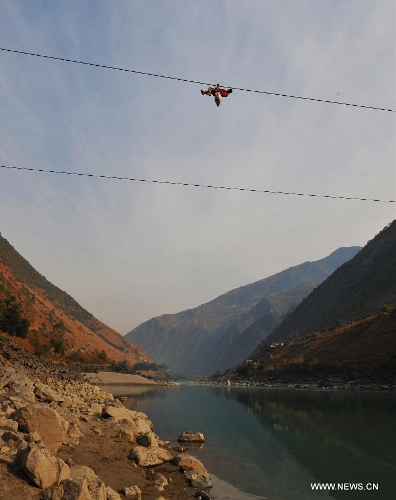
A resident from Shuangmidi Village crosses the Nujiang River via a zip-line in Liuku County of Nujiang Lisu Autonomous Prefecture, southwest China's Yunnan Province, Feb. 2, 2013. More than 98 percent of Nujiang Lisu Autonomous Prefecture is occupied by mountains and valleys. The zip-lines have been quite popular transportation method along the Nujiang River since the ancient time. However, as transport conditions improve in recent years, a growing number of traditional zip-lines along the Nujiang River Valley have been dismantled or replaced by bridges. (Xinhua/Wang Changshan)
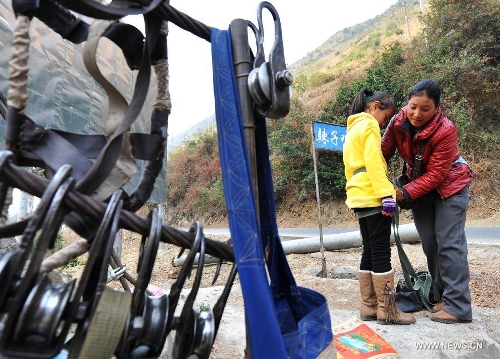
Residents from Shuangmidi Village make preparations before crossing the Nujiang River via a zip-line in Liuku County of Nujiang Lisu Autonomous Prefecture, southwest China's Yunnan Province, Feb. 2, 2013. More than 98 percent of Nujiang Lisu Autonomous Prefecture is occupied by mountains and valleys. The zip-lines have been quite popular transportation method along the Nujiang River since the ancient time. However, as transport conditions improve in recent years, a growing number of traditional zip-lines along the Nujiang River Valley have been dismantled or replaced by bridges. (Xinhua/Wang Changshan)
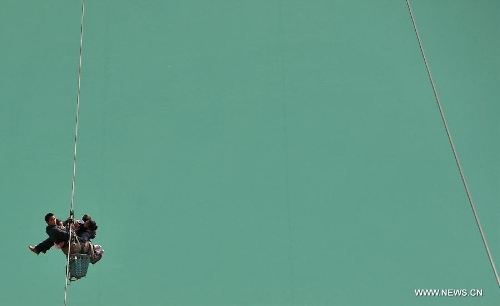
Residents from Shuangmidi Village cross the Nujiang River via a zip-line in Liuku County of Nujiang Lisu Autonomous Prefecture, southwest China's Yunnan Province, Feb. 2, 2013. More than 98 percent of Nujiang Lisu Autonomous Prefecture is occupied by mountains and valleys. The zip-lines have been quite popular transportation method along the Nujiang River since the ancient time. However, as transport conditions improve in recent years, a growing number of traditional zip-lines along the Nujiang River Valley have been dismantled or replaced by bridges. (Xinhua/Lin Yiguang)
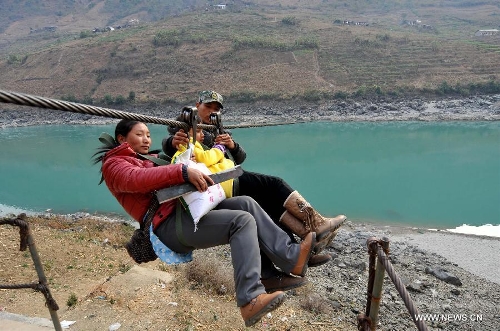
Residents from Shuangmidi Village cross the Nujiang River via a zip-line in Liuku County of Nujiang Lisu Autonomous Prefecture, southwest China's Yunnan Province, Feb. 2, 2013. More than 98 percent of Nujiang Lisu Autonomous Prefecture is occupied by mountains and valleys. The zip-lines have been quite popular transportation method along the Nujiang River since the ancient time. However, as transport conditions improve in recent years, a growing number of traditional zip-lines along the Nujiang River Valley have been dismantled or replaced by bridges. (Xinhua/Lin Yiguang)
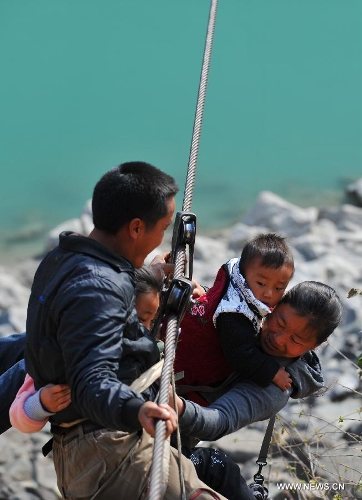
Residents from Shuangmidi Village cross the Nujiang River via a zip-line in Liuku County of Nujiang Lisu Autonomous Prefecture, southwest China's Yunnan Province, Feb. 2, 2013. More than 98 percent of Nujiang Lisu Autonomous Prefecture is occupied by mountains and valleys. The zip-lines have been quite popular transportation method along the Nujiang River since the ancient time. However, as transport conditions improve in recent years, a growing number of traditional zip-lines along the Nujiang River Valley have been dismantled or replaced by bridges. (Xinhua/Wang Changshan)
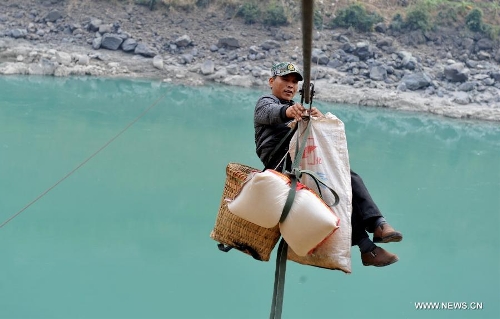
A man from Shuangmidi Village crosses the Nujiang River via a zip-line in Lushui County of Nujiang Lisu Autonomous Prefecture, southwest China's Yunnan Province, Feb. 2, 2013. More than 98 percent of Nujiang Lisu Autonomous Prefecture is occupied by mountains and valleys. The zip-lines have been quite popular transportation method along the Nujiang River since the ancient time. However, as transport conditions improve in recent years, a growing number of traditional zip-lines along the Nujiang River Valley have been dismantled or replaced by bridges. (Xinhua/Lin Yiguang)
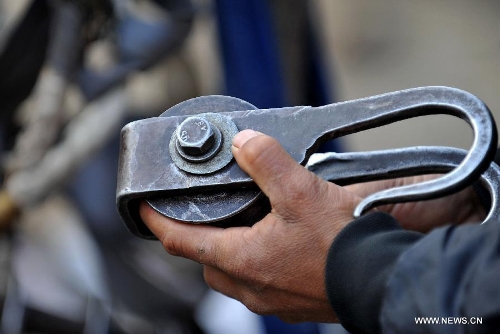
A resident of Shuangmidi Village holds a metal pulley used on a zip-line before crossing the Nujiang River in Liuku County of Nujiang Lisu Autonomous Prefecture, southwest China's Yunnan Province, Feb. 2, 2013. More than 98 percent of Nujiang Lisu Autonomous Prefecture is occupied by mountains and valleys. The zip-lines have been quite popular transportation method along the Nujiang River since the ancient time. However, as transport conditions improve in recent years, a growing number of traditional zip-lines along the Nujiang River Valley have been dismantled or replaced by bridges. (Xinhua/Lin Yiguang)
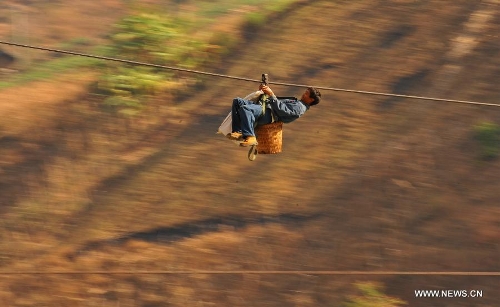
A resident from Shuangmidi Village crosses the Nujiang River via a zip-line in Liuku County of Nujiang Lisu Autonomous Prefecture, southwest China's Yunnan Province, Feb. 2, 2013. More than 98 percent of Nujiang Lisu Autonomous Prefecture is occupied by mountains and valleys. The zip-lines have been quite popular transportation method along the Nujiang River since the ancient time. However, as transport conditions improve in recent years, a growing number of traditional zip-lines along the Nujiang River Valley have been dismantled or replaced by bridges. (Xinhua/Wang Changshan)
Posted in: Gallery, China